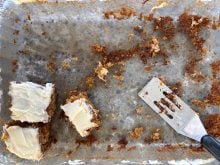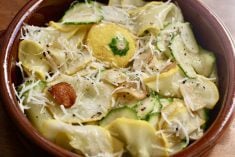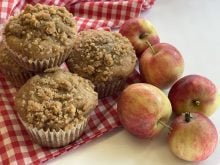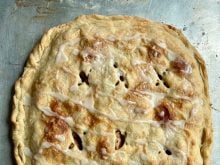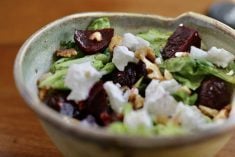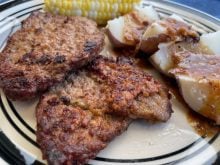We never had a traditional pantry on the farm, a place with deep shelves for storing dry goods or baking needs such as chocolate chips, walnuts, raisins and icing sugar. In those long-ago days, such items were too expensive to keep on hand.
Today, almost every new house has a pantry. I love these spaces and I love organizing them, because they seem to get disorganized very quickly.
I decided it was time to clean the bottom shelf of my pantry, the repository for unused small appliances and boxes of recipe books. While I was sorting through the boxes, I took a walk down memory lane.
Read Also

VIDEO: Bittersweet harvest for this family farmhand
Bruce Burnett helps his brother harvest wheat and canola for the last time on the family farm in Manitoba where they both grew up.
I perused several recipe books and chits of paper with handwritten notes referencing who had shared the recipe and what changes had been made to the ingredients or measurements.
I looked through pages torn from magazines, recipes from co-workers, sisters and community members, publications from various utility companies, grocery stores, appliance retailers, and instructions for making appealing dishes from the latest canned or packaged goods.
I felt nostalgic for the so-called “olden days” when a recipe collection was front and centre on the kitchen counter, not accessed by typing in key words on an internet browser. To be fair, I am guilty of using the internet for a quick supper idea or a dessert showstopper to take to a friend’s house.
I spent a lovely afternoon looking through my recipe collection and thinking about old friends and get-togethers. My Grade 9 home economics binder (circa 1966) is still the kingpin of my collection. I covered the front and back with red and white checked material and pasted black felt letters “My Recipes” on the front.
My teacher in that class was very thorough and supplied us with a tome of information on “making your food dollar stretch.” I’m sure it stuck because I think of some of those techniques to this day.
In Grade 9 I learned how to make bechamel sauce and crème caramel, which I still make. My teacher (and my mother) instilled a lifelong love of collecting recipes.
My stash revealed recipes written on lined paper or recipe cards, photocopies shared by people at work, pages ripped from magazines, pamphlets or brochures picked up at trade fairs, cookbooks compiled by 4-H clubs or church groups, and collections of recipes from other countries.
As I looked through my collection, I wanted to start cooking some of my favourite recipes right away. I also began thinking of the many meal preparation ideas created and shared through the years for making meals easier, more appealing and more economical.
My most treasured cookbook is the Blue Ribbon Cookbook that was one of my mother’s favourites. Originally printed in 1905, I have a copy of the 23rd edition. Though I do not use it for its recipes, I love to read it to get ideas. It is a small book and the recipes are concise.
The Five Roses Cookbook, copyrighted in 1915, is also simple and straightforward. For instance, the recipe for Buttermilk Pie is 2 cups buttermilk, 2 T. Five Roses Flour, 2 T. butter, 2 eggs, 1 cup sugar. Bake with an undercrust. This cookbook assumes the cook has been around the block a few times.
The Carnation Cookbook, printed in 1947, uses irradiated Carnation homogenized, unsweetened evaporated milk “from contented cows,” no less. Something called Roly Poly Pudding uses beef suet, flour, sugar, baking powder, salt and Carnation milk.
A sort of cinnamon bun with raspberry jam is cooked in a funnel cake pan and steamed for three hours. Honestly, I’ve never heard of this dessert.
My favourite recipe in the Women of Unifarm Cookbook, printed in 1971, is Scalloped Potatoes on page 51. It is a never-fail recipe that is always a crowd favourite. That page is well-worn, stained and contains notes, phone numbers and scribbles. Too funny.
Nabob published “Time-honoured Recipes of the Canadian West” in 1973, including lots of great recipes to serve with a nice cup of coffee, tea or juice. The centrefold showcases “a rich variety of spices,” many of which I still have in my pantry — expired though they may be.
In the 1980s, Canadian Living magazines were my go-to for recipes when I wanted to create a meal for a special occasion, but mostly I drew my daily meal ideas from “Be a Y’s Cook”, produced by the YMCA Nursery School staff where I was involved in a youth project.
I saw my collection of Best of Bridge and Company’s Coming cookbooks tested thoroughly in the early 2000s. I loved the quips and puns that appeared with each recipe in The Best of Bridge. For example, the observation at the bottom of page 19 for Midnight French Toast in the “Rest of the Best” is “Wrinkled was not one of the things I wanted to be when I grew up.” The ladies from the Bridge Club in Calgary must have had great fun putting those volumes together.
Throughout the last 10 to 15 years, I have resorted to searching ideas for meals and potlucks from baking shows on TV and the internet. I often print the recipes and keep them in a three-ring binder. Miss Rekimovich would be proud to know I still use my recipe book from her Grade 9 home economics class.
I created a few recipe books on my own for my children, with all their favourite foods typed and pasted in a coil scribbler for use when they were in charge of supper. Now, my daughter searches for recipes online and has started her own collection, although hers resides in a special folder on her phone.
Her husband is also a good cook, but he is old school. He often prints the recipe and refers to it as he makes his way through.
My massive pile of recipes and cookbooks from the bottom shelf of my pantry got me thinking. Recipe collecting is not a hobby, it is a cultural phenomenon. Those before us saved recipes, shared recipes, and made adjustments. Sometimes we add our own touch or we experiment. Most of us are hesitant to throw any recipe away, and keep our cookbooks not only for the recipe but for the notes we have written on the pages through the years.
I have shared ideas for cooking in other countries and picked up cookbooks in my travels to try the recipes at home — sometimes successfully, sometimes not.
Using a recipe is an invitation to take a journey. Following the steps in order can be crucial, but you may be the type who likes to take charge. You’ll find out soon enough if order is important.
The most endearing aspect about recipes is that they are a record. They reveal how techniques and tastes have changed. They remind us of the people and places we’ve been and the memories we have of those special times.
They can serve as ice breakers or they can be the main topic of conversation. They are the glue that holds households together and a legacy we leave to others. They are, simply put, the tie that binds.





